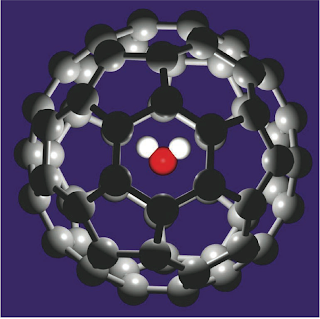Note: I did not blog yesterday due to Internet solidarity against CISPA.
Fullerenes are large molecular cages built entirely of carbon atoms, and researchers have been able to modify their properties by trapping other atoms inside the cage. Writing in Physical Review Letters, two theorists offer an analysis of a more recent invention, a fullerene containing a single molecule of water. They show that it responds in a surprising way to an electric field, allowing the whole structure to be driven in either direction through a narrow channel. Although it’s not completely clear why an object with no net charge should respond in this way, the researchers suggest that their discovery could have practical applications, such as delivering drugs by guiding molecules that carry them.
The most-studied fullerene is C60, a roughly spherical molecular shell made of 60 carbon atoms. Two years ago researchers used organic chemistry “surgery” to open C60, insert a water molecule, and seal the incision, creating a structure designated H2O@C60.
Baoxing Xu and Xi Chen of Columbia University in New York City have now used computer simulations to explore the properties of this structure. Their simulation captures all of the interactions between the carbon atoms and the three atoms of the water molecule. The researchers treated the C60 as a rigid structure, undistorted by its cargo, because the 1-nanometer-diameter cage is so much larger than H2O. They then placed the simulated H2O@C60 inside an 8.2-nanometer-diameter carbon nanotube.
American Physics Society: Pushing a Fullerene Through a Nanotube

Comments